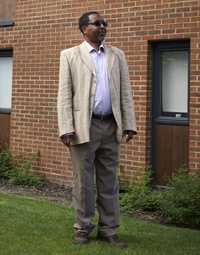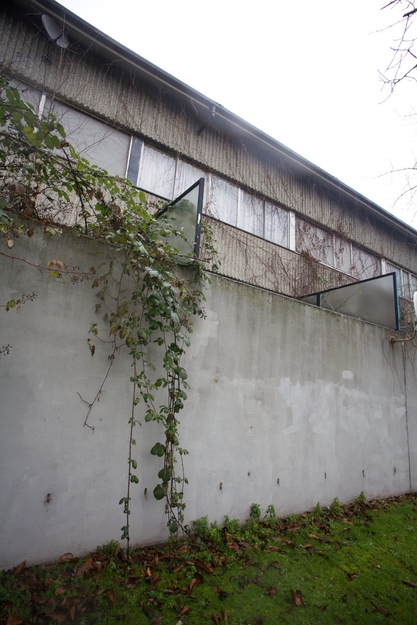You are viewing 1 of your 1 free articles
Ferrier estate reborn
Over the past three years, the Ferrier estate in south east London has undergone a major transformation. Emily Rogers investigates
A lot can happen in three years. Few places provide such a demonstration of this potential for change than the newly-created Kidbrooke Village in south east London. Kidbrooke train station is ablaze with banners welcoming visitors to ‘a new village for London’.
Just a few steps down a walkway and you arrive in the village square, complete with a Sainsbury’s Local and a coffee shop with brown leather sofas, displaying a latté list to rival anything in the City. Pristine sunlit flowerbeds and a cluster of inward-facing wooden benches stand in the square, immaculate but vacant, save for a few tea-breaking builders in high-vis jackets.
Change of scene
Overseeing it all are the huge dark windows of Kidbrooke Village information centre, offering a high-tech display of one of the most ambitious regeneration projects in Europe.
‘It’s just such a completely new place altogether,’ says former Ferrier resident Hamida Pyne, who moved out of the estate with her family four years ago and has mixed feelings about the changes. ‘If somebody had been in the Ferrier and had gone away for a few years and been taken back there, they would have definitely said they’d been taken to the wrong place.’
This isn’t hard to imagine. I visited this place three years ago, in the dying days of its previous life as the Ferrier estate, to interview tenants living in the shadow of the wrecking ball.
At the time, repossession orders were starting to fire through the letterboxes of the 190 tenants who still lived there, so work could start on phase two of Kidbrooke Village, a £1 billion, 4,000-home regeneration project led by Berkeley Homes in partnership with Greenwich Council. On the development’s completion, 1,525 of these will be affordable, of which 738 will be let at social rents. There were 1,910 social homes on the original Ferrier estate, although some had been sold under the right to buy.
New beginnings
To the outsider, it wasn’t hard to see why the decaying concrete hulks were chosen as the backdrop for drugs and violence in the gritty 1997 Gary Oldman film, Nil by Mouth. Three years later, the most apt film that springs to mind is The Truman Show, about a man in a pristine town that turns out to be a film set.
Now half of the development’s six phases are either completed or under construction and 195 of the Ferrier’s former 1,900 or so households have set up home here, living in some of the village’s first 832 homes. They are part of an estimated 2,300-strong community with dramatic variations in wealth. Some have shelled out around £1 million for property.
Nick Russell, chair of the former Ferrier Residents’ Action Group, says: ‘The disappointment was that we thought it would be a rolling development of new homes for the Ferrier community. It turned out to be new homes mainly for other people.’
Shop owner Niall O’Brien has run a coffee kiosk at Kidbrooke station for the past four years, giving him the opportunity to observe striking changes in the people coming and going since the bulldozing and building began. He describes the demographic changes as nothing short of a ‘quantum leap’.
‘Most of the Prada and Burberry you see now is actually real,’ he says.
The village centre, which also includes a doctor, dentist, village store and medical centre, turns out to be a temporary cluster of portakabins, to create the look and feel of a village before the completion of a permanent centre in five to 10 years.
But on walking away things start to feel more real. The Holy Family Primary school is unchanged, its playground jumping with noisy children, instilling life in its surroundings and providing a fleeting flash of déjà vu to my last Ferrier visit three years ago.
The school gives a sense of continuity to the former Ferrier families, many of whom live opposite it in a row of smart townhouses. They are very happy, according to a Berkeley-commissioned ‘social sustainability’ study carried out last year.
Learning to mingle
Walking around the pristine flowerbeds and acres of green parkland, it’s not surprising that the development scored highly on most indicators used to measure people’s well-being in their neighbourhood. But it scored below average for ‘links with neighbours’.
John Anderson, chair of Berkeley Homes East Thames, is keenly aware of the challenges of building a community from scratch. ‘My experience with the Royal Arsenal [a previous Berkeley development] is that it takes time to get people to talk to each other. It probably takes about 10 years,’ he says.
Tenures are mixed where possible in the village’s streets and apartment blocks, although social tenants are housed together to ‘help the decant’ from the Ferrier. ‘I’m hoping the tenures will blend with time,’ he adds.
Back at the temporary village centre, the huge pile of rubble behind Sainsbury’s leaves a parting reminder of the changes ahead. The Ferrier may have been reduced to dust, but its community wasn’t. Some 195 of its households are now anchored here, amid private renters and those dangling on different rungs of the property ladder. As the number of households multiplies at least five fold over the next 15 to 20 years, making a reality out of Berkeley’s ‘one community’ phrase in its marketing banners surrounding the rubble will prove one of its biggest building challenges.
The shared ownership tenant

Source: Julian Anderson
Starbucks supervisor Justyna Szczepaniak, 35, moved into her bright, two-bedroom shared ownership flat in September 2012, with her husband Marcin and two children, five-year-old Zofia and Antoni, three months.
The family previously shared a rented three-bedroom house in Hillingdon, north west London, with Justyna’s brother’s family. But as their daughter grew and Marcin started having to leave home at 6.30am for a new job in Southwark, they realised it was time to move. Looking for shared ownership opportunities in south London, the couple found they were eligible for a Southern Housing home in Kidbrooke Village.
The estate was a blank sheet for Ms Szczepaniak, as she hadn’t known about the Ferrier. ‘When I first saw this place, I cried,’ she recalls. ‘I wanted to stay in Hillingdon. My brother and my sister-in-law are my only family in this country. I had friends in Hillingdon and a job there. But I didn’t know anybody here. At the beginning, I was scared and lonely.’
But she has since had her second child, Antoni, here and has built up a small group of friends in her shared ownership block and at the gates of Holy Family Primary School, where her daughter Zofia is ‘very happy’.
‘My neighbours are really nice people; I like them,’ she says.
There are things she’d like improved, such as bus links to the village. And she shares her neighbours’ concerns about Berkeley’s proposal for a controversial 31-storey tower block. ‘I hope they won’t build that, as it’s not much of a villagey thing,’ she says. ‘I hope they’ll keep as many green areas as possible.’
Ms Szczepaniak sees the flat as a temporary stepping stone for her family, as they are likely to outgrow it in several years. But she says it will be hard to move somewhere else again after making friends here.
The homeowner

Source: Julian Anderson
Industrial engineer and 36-year-old mother of two Sandra Reinholc lives in a three-bedroom townhouse in Boyd Way with her husband Bart, son Lucas, six, and daughter Mila Sophia, 11 months.
The family moved here from their two-bedroom flat in Blackheath Village in September 2012. Her son Lucas is at school in Blackheath, just four minutes away by train.
The couple opted for Kidbrooke Village after scouring the surrounding area for a house within their price range as close as possible to her son’s school in Blackheath and within a quick commute of Mr Reinholc’s workplace in Canary Wharf.
‘I saw the first houses being built and I thought I wouldn’t mind one of those,’ says Ms Reinholc. ‘And as soon as I saw round one, I just loved it right from the beginning.’ She was initially very wary, however, due to the Ferrier estate’s reputation. ‘I knew what was here before,’ she says. ‘We knew perfectly well what the Ferrier looked like.’
But Ms Reinholc was reassured by the fact that the new development was being built from scratch and she says it’s a move they’re very glad they made.
‘I feel so lucky that I live just here,’ she says, as she strolls through Sutcliffe Park, which has been joined to the village’s new parkland with footpaths. ‘In just two minutes, I’m in this beautiful park.’
She has bonded with her neighbours, whose son also attends her son’s school. But she sees the 31-storey tower block proposed by Berkeley as a blot on the horizon of the green environment she has come to love. ‘That’s something I do feel a bit concerned about,’ she says. ‘They’ve done such a great job transforming this area, but they want to make it crowded again. That’s like building a tower block in the middle of Greenwich Park.’
The former Ferrier tenant

Source: Julian Anderson
Somalian father of seven Mohamed Ajami, 54, has finally fulfilled his dream of keeping his extended family together on the same estate. He, his wife and his then six children, who were squeezed into a four-bedroom house on the Ferrier estate, were among the last to move out of his ‘ghost town’ in March 2012, due to the difficulty of finding a large enough replacement home to accommodate them.
But two months later, his family was rehoused in two of the village’s brand new townhouses. Mr Ajami, a town centre warden in Woolwich, now lives in a four-bedroom house in Gerrard Way with his wife and five youngest children, ranging in age from 12 weeks to 16 years. His two oldest children, aged 21 and 19, live with his sister down the road.
Mr Ajami’s rehousing journey was a painful one. In February 2012, he lost his 82-year-old disabled mother, who lived in a separate block on the estate. She died of a pulmonary illness, which he believes was worsened by the living conditions in her condemned building. Mr Ajami recalls how the council moved swiftly to rehouse his family in the new development as quickly as possible, thanks to the intervention of housing director John Clark.
‘At least we’re not overcrowded now,’ says Mr Ajami. ‘And we’re together. [The council was] saying that [it would] have to disperse us all in Greenwich borough. But I wanted my family in one place and it’s my right to stay in one place.
‘The house was good and it was new. The children got better. Three of them had asthma in the old house. I found my old friends here and my children could stay at their schools and be surrounded by the same places they’re used to. The house is just right; new comforts, new technology, everything.’
But Mr Ajami misses the closeness of the former Ferrier community, who he describes as becoming ‘one family’. And he feels a sense of separation from the new homeowners moving in, some of whom he believes have a ‘bad idea’ of the Ferrier. ‘I’ve lived here for 13 years and now see it as a divided community. There used to be a strong community in the Ferrier and now there isn’t any more. That’s sad.’
Mr Ajami still gets emotional when he passes the place where his mother’s block used to be. ‘Every time I’m there, I say goodbye to her,’ he says.























